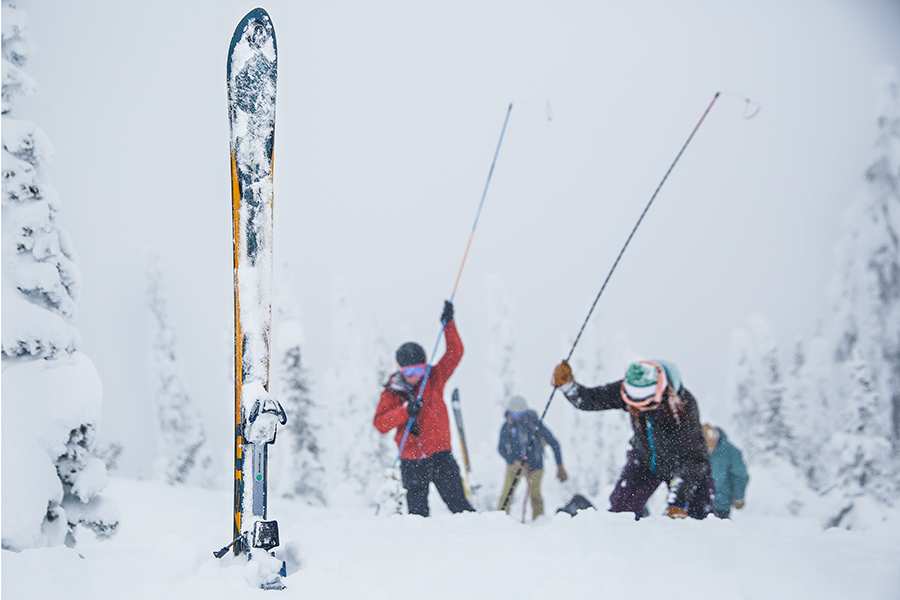Flattening the Curve of Avalanche Fatalities
Following the second consecutive winter season with zero avalanche deaths, Flathead Avalanche Center touts growth and education
By Tristan Scott
Efforts to “flatten the curve” of coronavirus infection have dominated the public health landscape in Montana since March 13, which is precisely when an Arctic air mass pushing across the Continental Divide carried new snow and sub-zero temps to Northwest Montana, and with it a late-season spike in avalanche danger.
On March 16, after a two-week period that proved to be the quietest of the 2019-20 winter season, the Flathead Avalanche Center (FAC) reported 30 slides in its forecast area, and on March 22 a snowboarder was carried and slightly injured in a loose dry avalanche above Marion Lake in the Flathead Range.
As Montana assesses its efforts to protect the public health and safety of its residents from a global pandemic, the FAC has taken a look back at last winter, which saw continued growth among backcountry skiers and snowboarders but zero fatalities and no injuries or accidents requiring rescue.
“This is the second season in a row without an avalanche fatality within our forecast area, and we went the entire winter without an injury or accident that required rescue,” FAC Director Zach Guy wrote in his annual report published this month. “This is what we strive for, and something that everyone can be proud of. This reflects a larger and more robust pattern at the national scale of a flattening curve in avalanche fatalities despite exponential growth in backcountry users.”
In Montana, outdoor recreation is a core value, further testament to which came when Gov. Steve Bullock’s stay-at-home order this spring listed outdoor activities essential.
“I have no doubt that the unprecedented impacts of the COVID-19 pandemic will cause agencies, businesses, and public donors to re-examine their priorities in upcoming years,” according to Guy. “I ask that our supporters also examine the contents of this report, which highlights the progress of the FAC in recent years and the value it brings to public safety as a return on your investment.”
That progress includes greater public engagement as well as state and federal support, which has allowed FAC to bolster its staff of forecasters and the suite of content they produce, including daily avalanche forecasts and advisories, and a winter curriculum brimming with educational opportunities.
The Flathead Avalanche Center operates through the U.S. Forest Service, although it also receives financial support from Glacier National Park, the Montana Recreation and Trails Program, and its nonprofit partner, the Friends of the Flathead Avalanche Center. FAC operations are based out of the Hungry Horse Ranger Station in Northwest Montana, and include a staff of four avalanche specialists and a professional observer.
Most of the center’s engagement with backcountry users takes place digitally, through its online platform at flatheadavalanche.org. The website houses all of the avalanche forecasts, observations, media, reports, and other information supplied by the FAC. According to FAC’s annual report, this year’s website statistics reflect the most dramatic growth since the site was launched in 2012, with a 43% increase in unique visitors compared to last season.
Website page views have more than doubled since 2015, and the list of email subscribers who receive daily forecasts surpassed 1,050.
Another metric for improved engagement with the backcountry skiing community was evidenced in the number of recorded observations, which provide the foundation for FAC’s daily forecasts by validating predicted avalanche activity and documenting snowpack and weather conditions. The FAC relies on observations from the public, its own forecasters and professional observers, including FAC interns, paid observers, and professional forecasters at the BNSF Railway and Going-to-the-Sun Road avalanche safety programs.
In the 2019-20 winter season, the FAC logged 508 observations between Oct. 10 and May 7, marking a 13% increase over the previous season. Most of that growth came via public observations, Guy said, continuing a positive trend from the previous four seasons.
The FAC also increased its social media presence, churning out content on Facebook, Instagram, Twitter, and YouTube in an effort to reach a broader audience.
“The goal is to steer users to our website while engaging them more frequently with avalanche information and short learning moments,” Guy said. “The goal of our videos is to form a holistic message incorporating snowpack observations into decision-making and terrain selection.”
In the fall, forecasters delivered a pair of workshops emphasizing the value of learning from near-misses and accidents in the backcountry community at the Northern Rockies Snow and Avalanche Workshop in Whitefish and the Southwest Montana Ski Patrols Snow Science Day in Bozeman.
Although no one died as the result of an avalanche in the FAC’s forecast area, the winter’s temperamental snowpack required a high degree of vigilance, which forecasters heeded carefully when January delivered a seven-week period of snowfall, and a natural cycle of destructive avalanches ran in the Flathead Range.
Despite the destructive storm cycle, the forecast area received only a few reports of near misses, incidents, or accidents, none of which involved serious injury.
“While good fortune certainly plays a role, these successes are also a result of increased investment in avalanche education and forecast products in our valley,” Guy wrote.